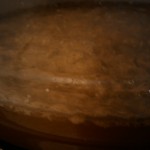Beer update: Gluten-free
I have a few friends with gluten issues, and it’s a fantastic challenge to be a good host when they come by. I’ve sought out roast recipes, and tried my hand at baking cookies. But I had never tried to brew beer before without some sort of glutenous malt. Fortunately, this is an active topic in the homebrewer scene, to the point that people are starting to malt their own grains (buckwheat and quinoa seem the most popular). The chief among these, and the most available on the market for homebrewers, is white sorghum. So when I saw the jars of sorghum liquid malt extract at the FLHS last fall, I knew to pick a couple up. And now with the fullness of time, I am finally making good use of it!
In a situation like this, where I have never used a particular variety of malt before, I go find a recipe to crib from. The one I went with was the Gluten-free McGee on Homebrew Exchange. It’s a 5-gallon recipe, so right off the bat I needed to make some tweaks; my setup is currently only capable of about 3 gallons. So I started by just scaling down the ingredients to my kettle setup, trying to keep the numbers about the same–OG, FG, IBUs, SRM, etc. Then I looked at the ingredients list closely, and saw that I had a good approximation of what was called for. The only thing I didn’t have was the dry rice extract, and when I went to the homebrew store to get the last bits of ingredients, I hadn’t seen any there. Fortunately, I had some brown rice syrup left over from the Sidhe’s (rather successful) attempt at vegan Rice Krispie treats. And then to add a little of my own kick, I factored in a little bit of molasses. Here’s the recipe I ended up with: Stovetop Sorghum Amber Ale
The sorghum malt extract tastes somewhat different than barley. Sweeter, perhaps, or maybe more like honey? I’ll certainly be interested to see how this flavor changes when all the fermentable sugars are chewed up. The rest of the process is pretty straightforward: boil the wort, add the hops, cool the wort rapidly, measure the volume & take a gravity sample!, calculate and add top-up water to fermenter, rack the wort onto the top-up water, pitch the yeast, and cap the fermenter with an airlock. The beer is currently bubbling away at 60℉! It has a relatively low krausen so far, which is acharacteristic from the other beers I’ve brewed. The yeast this time is Danstar Nottingham, which should be not too dissimilar to Safale’s US-05: clean, crisp, and well-attenuated. I want a little more bitterness to come through than the original recipe’s yeast (Windsor) would have provided.
My numbers are good. In fact, I ended up with a slightly high OG, even after top-up calculations! So I will hopefully net something like an extra quart of beer out of the final product. The biggest issue I had was during the late malt additions. My kettle is showing its lack of capacity–3 gallons is not enough to hold all the wort at a boil. Toward the end, I had a small second pot on a separate burner to handle the extra quart that didn’t fit! I should start looking for a 5-gallon pot, I guess. And here I was, hoping I had gotten all the equipment I needed for a while…
One extra note: I was able to take a few videos of the process, and they’re up on my YouTube channel: http://www.youtube.com/user/stovetopbrewing
And now, the photos:
- Fermentation is just getting going.
- The fermenter, filled with StarSan foam
- The krausen at full height for sorghum–not even a quarter of a barley malt beer!
- This little gadget aerates my wort using the Venturi effect!
- The hop gunk at the bottom of the kettle
- DO NOT LOOK AT ME HUMAN CONTINUE MAKING BEER
- Mmmm, smells good.
- The stars of the show: Sorghum, Nottingham yeast, and Saaz hops!
- Record-keeping is an important part of science!
- All my materials ready for the start of the boil.
- That orange tint lets you know that there is, indeed, iodine in solution.
- Racking the wort into the fermenter.
- The ice bath in my sink to cool the wort.
- Getting dressed for the debutante’s ball
- Taking a gravity sample with a hydrometer
















